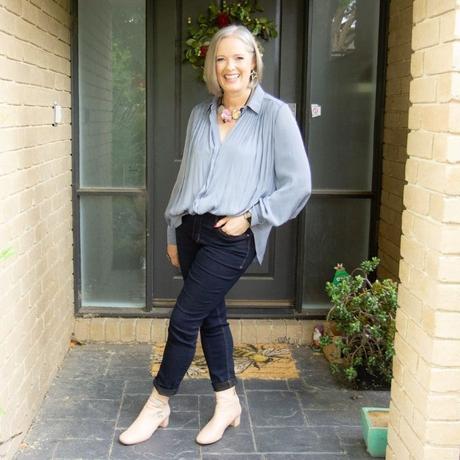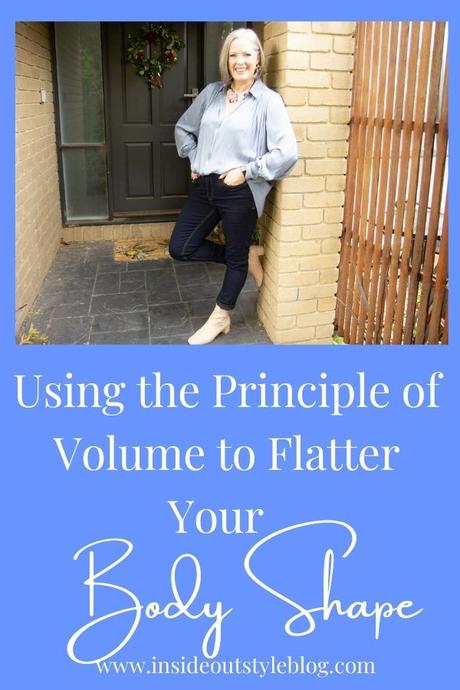



Balance is the concept of visual equilibrium. When we talk about dressing for your body shape and body proportions, what we are trying to do create visual balance. There are 4 main principles of co-ordination that influences how you achieve balance with your outfits. These are:
- Levels of Refinement
- Principle of Volume
- Related Shapes
- Related Lines
&iv;&modestbranding;&rel;&autohide;&playsinline;&autoplay;
When you attempt to balance your body shape with your outfit, the principle of volume is an important principle to remember as too much fabric will swamp you and can make you look larger. When two voluminous items are worn together, the look becomes boxy and shapeless and often out of balance and scale with your body. If you are very tall you may be able to get away with wearing two garments with volume. For everyone else, the fabric swamps you and it looks unbalanced.
When we’re talking voluminous, we are really talking about how much fabric is in the garment. A garment with a lot of fabric has lots of volume and can be overwhelming. By choosing to wear volume on your top half or volume your bottom will reduce the likelihood of you disappearing into a puddle of fabric.
In the video above, I’ve paired a voluminous blouse made from a lot of fabric with slim pants that is creating balance with my body shape. If I was wearing a wide-leg pant with this blouse, I would be overwhelmed with fabric. I could have worn the oversized blouse with a pencil skirt, straight cut jeans or capri pants. The slim lines of these garments balance out the oversized top giving me a shape which creates a more flattering and visually appealing look.
Not sure of your body shape? Take my free body shape calculator quiz – instructions and quiz here. Alternatively, join my 7 Steps to Style program for my professional opinion on your body shape (and face shape) plus colour analysis and so much more!
Unbalanced Body Shapes
If you have an unbalanced shape such as an A or V shape, the principle of volume suggests you want to wear a voluminous garment on the opposite area to that which is broader as this creates visual balance.
The V shape who has broader shoulders may not want to wear more volume on the top so will balance their body shape by wearing a fitted top paired with a bit of volume on the bottom to create balance – a tiered skirt or wide-leg or palazzo pant.
Those with an A shape may want to wear a bit more volume on the top to create balance with their bottom half. The A shape can also get away with the volume on the bottom, skimming over curves with flared skirt. Flared skirts work really well for A shape when paired with a fitted top. Balance can be achieved with horizontal lines around the shoulders; a little bit of a shoulder pad or other shoulder broadening details such as a boat-neck. Tuck in more voluminous tops to make sure you highlight your waist and not lose your shape.
Balanced Body Shapes
The I shape are typically long and lean with very few curves. The focus of this body shape should be on creating an illusion that you’ve got a waist by defining the waist and breaking up the long slim rectangle. Puffed sleeves, blouses with ruffles, wide-leg jeans and flared skirts will allow you to wear garments with volume and contribute to the visual balance of your outfit.
The O Shape is common among many women who experience symptoms of (peri)menopause and gain weight around your waist. Some women tend to cover up with loose garments which will make you look larger than you really are. Wear your looser-fitting tops with slimmer bottoms – such as straight skirts or slim pants or leggings.
8 shape – this shape may be balanced or unbalanced – depending if the shoulders and hips are similar widths or different. But the same guidelines work for both with regards to voluminous garments – wear more voluminous tops with your straight skirts and slimmer pants or leggings.
X Shape should avoid volume around their bust – frills or ruffles (unless you have a small bust). They should also avoid voluminous sleeves like bell sleeves, flutter sleeves, dolman sleeves as they add too much volume near your bust and shoulders and creates a top-heavy look. A cropped jacket that nips in at the waist is flattering because it builds curves without overemphasizing them but avoid peplum jackets that overemphasize your hip area with too much volume. For the same reason, pleated pants are not your friend… Tucking is a great way to wear something voluminous without losing your defined waist!
 H Shapes look great with more voluminous tops and slimmer bottoms – as you don’t have a waist that needs definition, so bypassing it and then highlighting your slimmer legs can be great. A half tuck, or tucking and blousing is the way to make sure your top doesn’t completely swamp you. If you want to wear a wider leg pant, then make sure you team it with a slim fit top.
H Shapes look great with more voluminous tops and slimmer bottoms – as you don’t have a waist that needs definition, so bypassing it and then highlighting your slimmer legs can be great. A half tuck, or tucking and blousing is the way to make sure your top doesn’t completely swamp you. If you want to wear a wider leg pant, then make sure you team it with a slim fit top.
Creating balance without volume
You can also balance your body using vertical and horizontal lines. Horizontal lines visually widen the area they are placed on and are created by most hems on garments. Verticals lines lengthen because our eyes move along them more quickly than they do on horizontal or curved lines.
If you’ve got a V shape with broad shoulders and you want to balance your upper body, you can wear a voluminous skirt and a fitted top but so the same balance can also be achieved with a tunic and a slim pair of pants as long as the tunic kind of ends around the thigh. Where the tunic ends, creates a horizontal line around the thigh that broadens the silhouette.
An A shape with curvy hips and thighs can balance your lower body by wearing a voluminous blouse. The same balance can also be achieved with tops that add width to your shoulders, like puffed sleeves, epaulettes, boat necks, ruched sleeves, square necklines.
Curved lines are the best friend of the I Shape – as out eyes follows its path, it’s curves slow us down adding volume and curves to our bodies. Curves create softness and approachability in an outfit or garment. Curved necklines, hemlines and organic shaped prints create the illusions of curves without adding fabric volume
An O Shape will find a v-shaped neckline reveals your collarbone widening the shoulders and breaking up your top half. Peplum and wrap tops are also specifically constructed to create a more defined waistline. Open-front jackets without closures flatter your frame by adding long vertical lines.
8 shape – this body is often quite naturally balanced draw attention to your slimmer waist with belts or just make sure tops and jackets are shaped in at the waist. If you have a narrower shoulders than hips, look for puffed sleeves and shoulder details to visually broaden that area.
For X Shape women, pocket details around your hips make this area seem wider. Instead look for pants, jeans and trousers that don’t have any pockets at the hips and ensure that the overall silhouette of your garment is one that fits at the waist and flares around the hips.
H Shapes are naturally balanced so can wear fitted garments from head to toe quite easily. Just make sure you have a focal point near your face to draw attention there, this is where a scarf or great pair of statement earrings or a fun necklace are such great accessories for you to enjoy.
Further Reading
Want to Figure Out Your Body Shape? Try My Quiz
Get Your Body Shape Bible Here
What Guidelines to Follow When Your Body Shape isn’t “Standard”
Brilliant Tricks of the Clothing Magician – How to Highlight and Camouflage for Figure Flattery
The Aesthetics of Beauty and Style and How They Relate to Fashion







